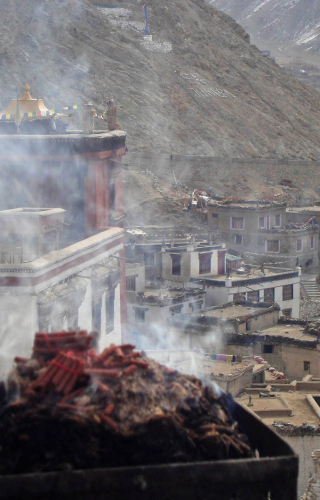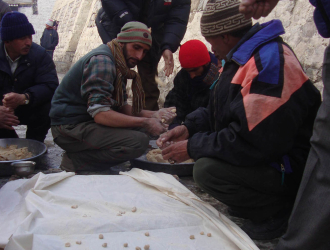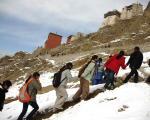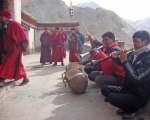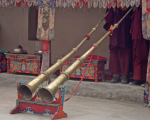Dosmoche is an annual religious festival held in Leh to mark the end of the year according to the Tibetan Lunar calendar. It is held over two days, on the 28th and 29th days of the 12th month of the Tibetan Lunar calendar, usually in February. The festival marks the triumph of good over evil, calling upon the gods for their blessings and protection for the approaching year.
Several monasteries in Ladakh send their monks to take part in the festival, from making the ritual torma (stor-ma) to performing masked dances and playing sacred instruments. At the centre of the celebrations is a large, colourful and intricate thread cross called ‘dosmo chenmo’ (mDos-mo Chen-mo, literally ‘large thread cross’), from which the festival acquires its name. Made by monks from Takthog Monastery, it is said that evil spirits get entangled in the complex web of this thread and later perish in the fire when the thread is burnt at the end of the second day of the festival.
The festival is held in a courtyard (cham ra) below Leh Palace next to the Gompa Soma Monastery. In the past, when the king and queen of Ladakh lived at the palace, they would preside over the ceremonies; but even when they left, the royal entourage would ride in on horses from Stok, dressed in their best attire. At the end of the second day, the thread cross would be taken out of the palace followed by a large procession of monks, nobility and common people. Passing through the palace gate at Stalam, the cross would travel through Leh Bazaar, eventually making its way to a site known as Katmochey where it would be burnt. Katmochey—now opposite the Polo Ground of Leh—is a large, slightly depressed open space at the foot of Leh Palace on the eastern side.
During the two days, the market of Leh takes on a festive appearance as people from neighbouring villages visit, meet friends, shop, take part in various games and gamble. Dosmoche celebrations are organised by the Leh phum-do, the original residents of the Old Town in Leh, many of whom no longer live in the town but continue to keep their connections with it.
